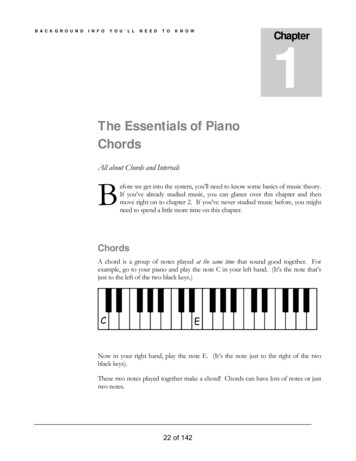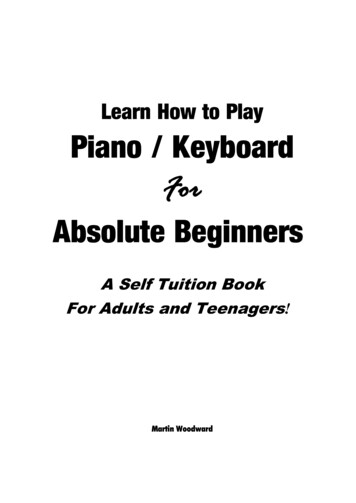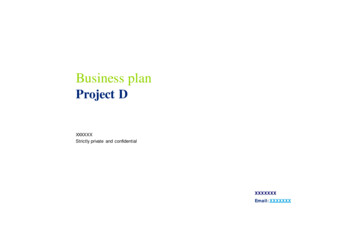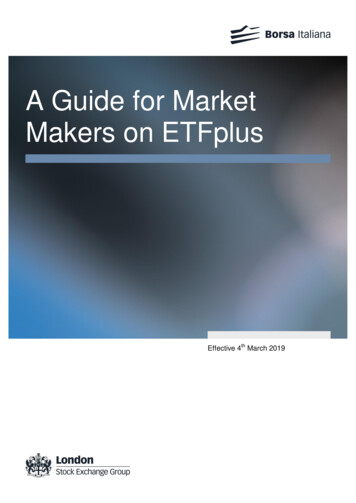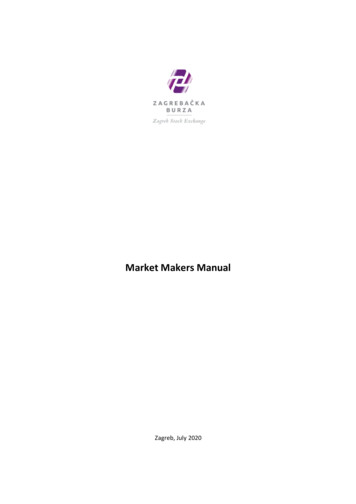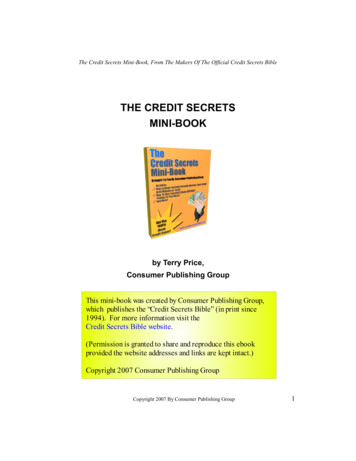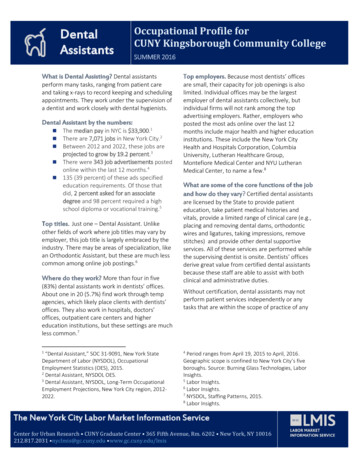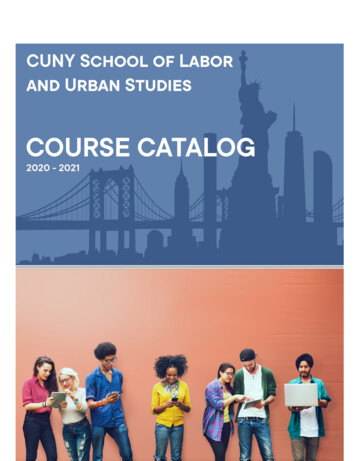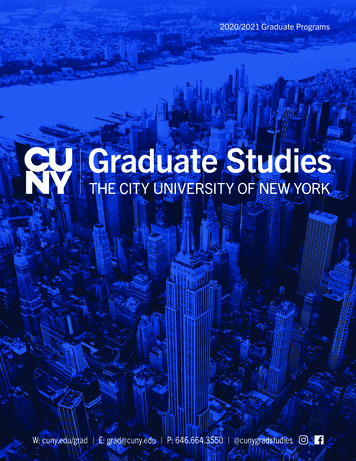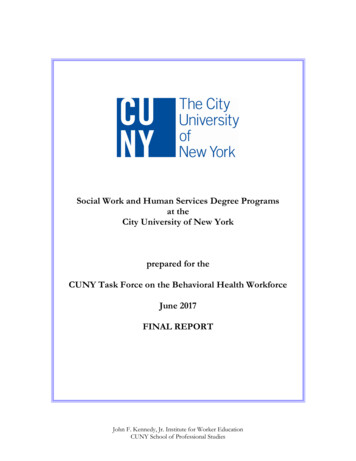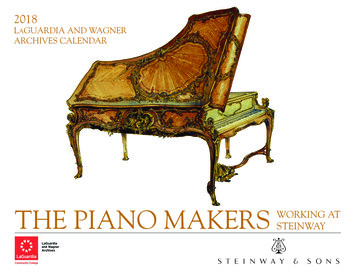
Transcription
2018LAGUARDIA AND WAGNERARCHIVES CALENDARTHE PIANO MAKERSWORKING ATSTEINWAY
ABOUT THE ART CASE PIANOSThe first art case piano was made in 1855 by Steinway.Between 1855 and 1930, Steinway produced over 200“fancy pianos” for special customers in the United Statesand Europe. Customers included the Goulds, Fricks, andRothschilds.Art case pianos were custom-designed to suit particularclients.The designs were not always made into pianos.Cover: Louis XV art case piano, c. 1901Below: Grecian art case piano, c. 1910
THE PIANO MAKERSThere’s something magical about a piano – the shiny ebony case,the “ivory” keys, and the gorgeous sounds that can come from it.For the people who build the Steinway piano, it is a labor of skill,artistry and commitment. This calendar tells their story.The founders of Steinway & Sons, then called Steinweg, cameto New York from Germany in 1850. They had been piano makers inthe old country, but America was particularly good to this immigrantfamily; within seven years they had built an immense piano factoryon Park Avenue at 53rd Street. With the technical genius of one son,Theodore, and the marketing skills of another, William, Steinway &Sons prospered.The Steinway piano garnered so much prestige that Europeansbecame interested in buying this American product. In 1880, oneSteinway brother returned to Germany to set up a factory in Hamburg tomeet this demand, while the family built another factory in Queens toexpand production for American customers.The twentieth century brought more prosperity; Steinway never soldmore pianos than in the 1920s. With its handsome profits, SteinwayWORKING ATSTEINWAYerected a magnificent new hall on West 57th Street, down the streetfrom Carnegie Hall.But the century also brought the Great Depression of the 1930s andwar. Twice the United States went to war with Germany, and Steinway,as an American company with a factory in Germany, found itself onboth sides of the conflict. During World War II, the Hamburg plant wasexpropriated by the Germans, who made it part of their war machine.The New York factory was enlisted as part of the American effort –making gliders and olive drab G.I. pianos.Steinway & Sons survived all this and remained in the family of thefounder until 1972. Steinway pianos are still being made in a modernplant at the century-old location in Queens where the family made itsfortune and thousands of workers – many of them immigrants – earnedtheir living. Today, when so many products are no longer “Made in theU.S.A.,” the Steinway piano endures as a symbol of American ingenuityand craftsmanship. This calendar salutes the men and women whoseskills made that extraordinary accomplishment possible.
Steinway factory at 19th Avenue and 37th Street, Astoria, Queens, 1888.
Dear Steinway Friend,Please enjoy this beautifulkeepsake calendar celebrating thehistory and legacy of Steinway &Sons, one of the greatest American successstories.Founded in 1853 in New York City,the company began as a tiny venture in aManhattan loft, a labor of love undertakenby German immigrant Henry E. Steinwayand his sons. Then, as now, the missionof the company was to “build the finestpiano possible.” More than 164 yearslater, Steinway’s uncompromised quest forperfection has never wavered. Our pianos areRon Losby, CEO, Steinway Musicalstill handcrafted at our New York factory usingInstrumentsthe time-honored techniques and processesthat have been passed down through generations of skilled craftspeople.In the fabric of American history, Steinway & Sons has been more than amaker of pianos; Steinway has been an integral thread in our cultural and sociallegacies. From the production of wooden gliders and “Victory Vertical” pianosduring WWII to the sponsorship of Van Cliburn’s history-making Moscowperformance, which helped to diffuse Cold War tensions, Steinway & Sons hasbeen behind the scenes of unforgettable American touchstones.Much of the information and many of the images featured in this calendarare available to us because of the long-standing relationship between Steinway& Sons and The LaGuardia and Wagner Archives at LaGuardia CommunityCollege/CUNY. The LaGuardia Archives, representing the largest repository ofSteinway materials in the world, has been a vital steward of Steinway’s heritagefor more than thirty years.I am very proud to be a part of this incredible company. I hope you, like me,thrill with the celebration of music, fine craftsmanship, and noble Americanhistory contained in these calendar pages.Dear Friends of LaGuardia and WagnerArchives,It’s with great pleasure that I welcome youto the 2018 LaGuardia and Wagner Archivescalendar: The Piano Makers – Working at Steinway.Steinway & Sons is the oldest functioning Queens-basedmanufacturer, having establishing its piano factory inAstoria in 1870 at a time when Queens was lightly populated. Steinway quickly constructed street railways andhousing that helped develop northwest Queens. Its richhistory extends even further, back to 1853, when theGerman-born immigrant Henry E. Steinway launchedGail O. Mellow, President,Steinway & Sons on Walker Street in Lower ManhattanLaGuardia Communityonly three years after arriving in this country.College, CUNYThe LaGuardia and Wagner Archives, under theleadership of Dr. Richard K. Lieberman, has housed the bountiful archives of Steinway & Sons for over thirty years. This remarkable collection of documents andphotographs records the history of the piano business and its employees from 1853 tothe present. Researchers from around the world have come to the Archives to learnabout topics ranging from the technical aspects of building a Steinway to genealogical questions about family members who worked for the company a century ago.Throughout the calendar you’ll find a variety of historic images: Steinway’scustom-designed art case pianos, men cleaning the piano’s iron plates and womenpinning together the piano’s action parts, Steinway family members playing croqueton its mansion’s front lawn, and workers and their families enjoying their free time atfestive gatherings.When Steinway & Sons opened its doors more than 160 years ago, it provided apath for its mostly German-speaking immigrant labor to achieve a measure of stability in a new country. LaGuardia Community College is proud to educate first-generation students, many of whom come from low-income families earning less than 25,000 per year. Many of these students are also immigrants or second-generationresidents striving for a foothold in a new country by preparing for a career in science,technology, engineering or math much as the Steinway family did in 1853.Sincerely,Sincerely,Ron Losby, CEOSteinway Musical InstrumentsGail MellowPresident, LaGuardia Community College, CUNY
ACKNOWLEDGEMENTSPROJECT ADVISORGail O. Mellow, President, LaGuardia CommunityCollege, CUNYThis calendar has incorporated much of the 1991 LaGuardiaand Wagner Archives calendar, The Piano Makers: Working atSteinway and would like to acknowledge those who prepared it.PROJECT DIRECTORRichard K. Lieberman, Director of the LaGuardia andWagner Archives and Professor of History, LaGuardiaCommunity College, CUNYPROJECT DIRECTORRichard K. LiebermanJanet E. LiebermanASSOCIATE PROJECT DIRECTORStephen Weinstein, Assistant to the Director, LaGuardiaand Wagner Archives, LaGuardia Community College,CUNYADMINISTRATIONHazera Jalil, LaGuardia and Wagner Archives, LaGuardiaCommunity College, CUNYCALENDAR DESIGNJesse Carbone, Carbone GraphicsLAGUARDIA AND WAGNER ARCHIVES STAFFSoraya Ciego-LemurDouglas DiCarloTara HickmanOleg KlebanAmanda MellingerStephen PetrusMolly RosnerVladislav YakubovSPECIAL THANKSRon Losby, CEO, Steinway & SonsAnthony Gilroy, Senior Director of Marketing, Steinway& SonsElizabeth Olson, Marketing Manager, Steinway & SonsAbove: Louis XIV art case piano, 1900Below: Rustic art case piano, 1902RESEARCHClifton HoodADMINISTRATIONEduvina EstrellaLAGUARDIA AND WAGNER ARCHIVES STAFFGladys BeyrutiMonica BlankRobert BruggermanRoberto FerreirasDawn KlisuresJulia SanchezDESIGNAbigail SturgesSPECIAL THANKSPia AndritsiYvette BermudezDebra BrownRandy Fader-SmithSusan FarkasWilliam FreelandAida GonzalezGeorge HamadaHeidi KingJohn KotowskiMina MalinMel SchiffMichael WeberKay ZelaskowskiPHOTO CREDITSAll photos are part of the Steinway & Sons Collection,housed at the LaGuardia and Wagner Archives, LaGuardiaCommunity College, CUNY
DEDICATION – HENRY Z. STEINWAYHenry Z. Steinway was the great grandson of the founder of Steinway & Sons. He followed in the footsteps of his father Theodore andgrandfather, William, and became president of Steinway & Sons in 1955. He led the piano company until its sale to CBS in 1972 and thenturned his attention to preserving the history of his family’s business, or as he put it, their “ancient history.” Henry arranged and annotated mostof the Steinway collection and his tireless efforts before his death in 2008 have made publications like this possible. Because of his commitmentand his immeasurable generosity, we are honored to dedicate this 2018 calendar to Henry Z. Steinway, piano maker and historian.
Left to right: Julia Steinway, Henry Cassebeer, George Augustus Steinway, Frederick Steinway, Marie Steinway, F.A.O. Schwarz, Charles Steinway, Ida Schwartz, Henry E. SteinwaySunday dinner for the Steinways meant inviting a few select friends from the wealthyGerman-American community to their country house in Queens for a grand lunch, alawn game like tennis or croquet, and coffee and cakes in the late afternoon. Picturedhere playing croquet with the Steinways are F.A.O. Schwarz and his daughter, Ida.Schwarz, in the full beard and top hat, was the celebrated dealer in toys whose retailstore “Schwarz, Toy Bazar” was located on Union Square, down the street fromSteinway Hall. Also in the scene are Charlie and Fred Steinway, the future presidentsof the company.The Steinway mansion in Astoria was a healthful retreat from the summer heatand the periodic epidemics of diseases like cholera that plagued Manhattan.
JANUARYSMTWTFS123456910111213NEW YEAR’S DAYKWANZAA ENDSTHREE KINGS DAY,FEAST OF THE EPIPHANY1829: Charles G. Steinway, son ofHenry E. Steinway, born in Seesen,Germany.1866: C.F. Theodore Steinway joinsSteinway & Sons partnership.78ORTHODOX CHRISTMAS1415DR. MARTIN LUTHERKING JR. DAY(OBSERVED)16171819202122VASANT PANCHAMI(HINDU OBSERVANCE)232425262730311968: LaGuardia CommunityCollege founded.28291863: Henry E. Steinway, Sr.becomes a U.S. citizen.William Steinway and his family inQueens, 1884.DECEMBER 2017SMTFEBRUARY 829302526272831INTERNATIONAL DAYOF COMMEMORATIONIN MEMORY OF THEVICTIMS OF THEHOLOCAUST
By 1860 the Steinway family had made their fortune in America. They built animmense piano factory uptown on 53rd Street and Fourth Avenue (now ParkAvenue) and bought land near the factory for their private residence and for realestate speculation. The documents pictured here are excerpts from the “Abstract ofTitle” to land that the founder, Henry Steinway, and his son, William, bought on thesoutheast corner of 53rd Street and Fourth Avenue.Charles F. Tretbar, an employee of Steinway & Sons, is named with his wife,Helen, as seller. They were being used by Henry and William to buy the land for thewealthy Steinways in order to keep the price down. The Tretbars paid 6,875 on May1, 1868 and sold it to Henry and William seventeen days later for the same price.The document on the right records the inclusion of C.F. Theodore and Albert,son of Henry, as joint tenants on the property with Henry and William. Their wives,Julia and Regina, are excluded. Henry Steinway signed this document two days beforehe signed his will, evidently putting his affairs in order. He died six weeks later, onFebruary 7, 1871.
FEBRUARYSMTWTF1256GROUNDHOG DAY31889: William Steinway forms theAstoria Homestead Co. to buy andsell Queens real estate.Steinway factory at 53rd Street andPark Avenue, 1890.4S7891516101871: Henry E. Steinway, Sr. dies inNew York City.1112TU B’SHVAT13LINCOLN’S BIRTHDAYMARDI GRASSHIVARATRI (HINDU)14VALENTINE’S DAYASH WEDNESDAY1880: Steinway & Sons varnisherslead a company-wide strike for higherwages after their pay is cut during therecent depression.18192526JANUARY 2018S20PRESIDENTS’ DAYLENT (ORTHODOX)27MARCH 61720212223242728293031171797: Henry E. Steinway, founderof Steinway & Sons, born HeinrichEngelhard Steinweg in Wofshagen,Germany.21DOMINICAN REPUBLICINDEPENDENCE DAYCHINESE NEW YEAR2822PURIM (BEGINS ATSUNDOWN)2324
Nahum Stetson, seen here in the 1890s, began as a salesman and rose quickly inthe ranks to become head of sales and marketing. In this lofty position, Stetsonneeded a lavish office to entertain Steinway dealers. Although Steinway dealers wereindependent merchants who often sold other, less expensive pianos, along with theSteinway, they were the company’s lifeline, its crucial connection to its customersthroughout the world.Nahum is seated at his desk which was, at that time, the last word in officefurnishings. When he opened his desk door, Stetson’s dealer files were at his elbow.To his left is a picture of an “art case” piano, an extraordinary piano with originalengraving or painting. Stetson helped establish the department that created thesepianos at Steinway & Sons, some of which are on the front and back of this calendar.Above Stetson’s desk is a large picture of his boss, the president of the company,William Steinway. The souvenirs on the fireplace mantle are gifts from Steinwaydealers, which he had to display in case one of them visited again.
MARCHSMTWTF1PURIMS2391016172324HOLI (HINDU OBSERVANCE)Detail of the above picture of NahumStetson’s office, showing an art casegrand piano.4561836: William Steinway, son ofHenry E. Steinw
fortune and thousands of workers – many of them immigrants – earned their living. Today, when so many products are no longer “Made in the U.S.A.,” the Steinway piano endures as a symbol of American ingenuity and craftsmanship. This calendar salutes the men and women whose skills made that extraordinary accomplishment possible. Steinway factory at 19th Avenue and 37th Street, Astoria .
